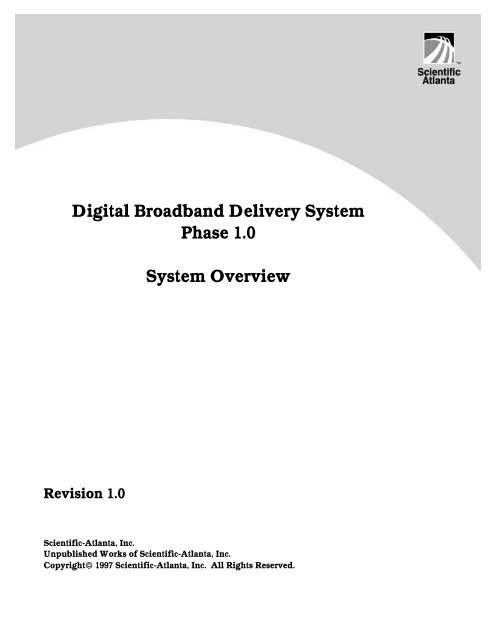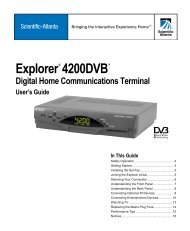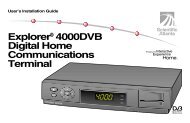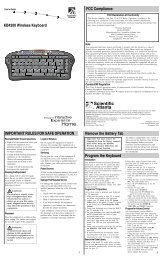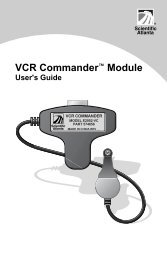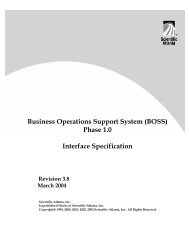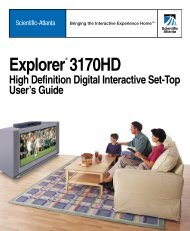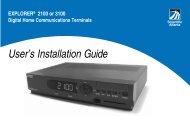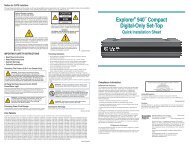Digital Broadband Delivery System Phase 1.0 ... - Scientific Atlanta
Digital Broadband Delivery System Phase 1.0 ... - Scientific Atlanta
Digital Broadband Delivery System Phase 1.0 ... - Scientific Atlanta
Create successful ePaper yourself
Turn your PDF publications into a flip-book with our unique Google optimized e-Paper software.
<strong>Digital</strong> <strong>Broadband</strong> <strong>Delivery</strong> <strong>System</strong><br />
<strong>Phase</strong> <strong>1.0</strong><br />
<strong>System</strong> Overview<br />
Revision <strong>1.0</strong><br />
<strong>Scientific</strong>-<strong>Atlanta</strong>, Inc.<br />
Unpublished Works of <strong>Scientific</strong>-<strong>Atlanta</strong>, Inc.<br />
Copyright© 1997 <strong>Scientific</strong>-<strong>Atlanta</strong>, Inc. All Rights Reserved.
NOTICE OF DISCLAIMER<br />
This interface definition/system overview is published by <strong>Scientific</strong>-<strong>Atlanta</strong>, Inc. (S-A)<br />
to inform the industry of the requirements and operational characteristics for<br />
interaction with the S-A <strong>Digital</strong> <strong>Broadband</strong> <strong>Delivery</strong> <strong>System</strong> for the delivery of<br />
broadcast and/or interactive video services.<br />
S-A reserves the right to revise this document at any time for any reason, including but<br />
not limited to, conformity with standards promulgated by various agencies or industry<br />
associations, utilization of advances in the state of the technical arts, or the reflection of<br />
changes in the design of any equipment, techniques, or procedures described or<br />
referred to herein.<br />
S-A makes no representation or warranty, express or implied, of any kind with respect<br />
to this document or the any of the information contained herein. YOUR USE OF OR<br />
RELIANCE UPON THIS DOCUMENT AND THE INFORMATION CONTAINED<br />
HEREIN IS AT YOUR OWN RISK. S-A shall not be liable to you for any damage or<br />
injury incurred by any person arising out of the your use of these materials.<br />
This document is not to be construed as conferring by implication, estoppel or<br />
otherwise any license or right under any copyright or patent whether or not the use of<br />
any information in this document necessarily employs an invention claimed in any<br />
existing or later issued patent.
Table of Contents<br />
1. Introduction ......................................................................................................................1<br />
1.1 Purpose ......................................................................................................................................1<br />
1.2 Scope..........................................................................................................................................1<br />
2. <strong>System</strong> Overview..............................................................................................................1<br />
3. <strong>System</strong> Service and Feature Capabilities .......................................................................3<br />
3.1 Service Capabilities .................................................................................................................3<br />
3.1.1 Analog Broadcast Service.............................................................................................................. 3<br />
3.1.2 Secure Analog Broadcast Service.................................................................................................. 3<br />
3.1.3 Analog Pay-Per-View Service ....................................................................................................... 4<br />
3.1.4 Analog Impulse Pay-Per-View Service......................................................................................... 4<br />
3.1.5 <strong>Digital</strong> Broadcast Service............................................................................................................... 4<br />
3.1.6 Secure <strong>Digital</strong> Broadcast Service................................................................................................... 4<br />
3.1.7 <strong>Digital</strong> Pay-Per-View Service ........................................................................................................ 4<br />
3.1.8 <strong>Digital</strong> Impulse Pay-Per-View Service.......................................................................................... 4<br />
3.1.9 <strong>Digital</strong> Near Video On Demand Service ...................................................................................... 5<br />
3.1.10 One-way Real-time Datagram Service ..................................................................................... 5<br />
3.1.11 Two-way Real-time Datagram Service..................................................................................... 5<br />
3.2 Feature Capabilities .................................................................................................................5<br />
3.2.1 Closed Caption............................................................................................................................... 5<br />
3.2.2 VBI Data.......................................................................................................................................... 5<br />
3.2.3 Copy Protection.............................................................................................................................. 6<br />
3.2.4 Multi-channel Audio...................................................................................................................... 6<br />
3.2.5 Multi-lingual Audio ....................................................................................................................... 6<br />
3.2.6 Blackout .......................................................................................................................................... 6<br />
3.2.7 Emergency Alert <strong>System</strong> ............................................................................................................... 6<br />
3.3 Operational Capabilities .........................................................................................................7<br />
3.3.1 Software Download ....................................................................................................................... 7<br />
4. <strong>System</strong> Architecture..........................................................................................................7<br />
4.1 <strong>System</strong> Configurations............................................................................................................8<br />
4.2 <strong>System</strong> Components and Subsystems...................................................................................9<br />
4.2.1 Headend Equipment.................................................................................................................... 11<br />
4.2.1.1 Analog Headend Equipment .............................................................................................. 11<br />
4.2.1.2 Real-Time Encoder............................................................................................................... 11<br />
4.2.1.3 <strong>Broadband</strong> Integrated Gateway ......................................................................................... 11<br />
4.2.1.4 QAM Modulator.................................................................................................................. 12<br />
4.2.1.5 QPSK Modulator.................................................................................................................. 12<br />
4.2.1.6 QPSK Demodulator............................................................................................................. 13<br />
4.2.1.7 LAN Interconnect Device.................................................................................................... 13<br />
4.2.2 Transport Infrastructure.............................................................................................................. 13<br />
4.2.3 Access Network............................................................................................................................ 14<br />
4.2.4 <strong>Digital</strong> Home Communications Terminal.................................................................................. 14<br />
4.2.4.1 DHCT Hardware Platform ................................................................................................. 15<br />
4.2.4.2 Operating <strong>System</strong>................................................................................................................. 15<br />
4.2.4.3 DHCT Applications............................................................................................................. 16<br />
4.2.5 Service Infrastructure................................................................................................................... 17<br />
4.2.5.1 Value-Added Service Provider Components and Subsystems........................................ 17<br />
4.2.5.2 <strong>Digital</strong> Network Control <strong>System</strong>........................................................................................ 19<br />
4.2.5.3 Administrative Gateway..................................................................................................... 20
4.2.5.4 Core Network....................................................................................................................... 21<br />
4.2.5.5 Network Management <strong>System</strong> ........................................................................................... 21<br />
4.2.6 PowerKEY Conditional Access <strong>System</strong> .................................................................................. 21<br />
4.2.6.1 Functional Description of PowerKEY <strong>System</strong> Components......................................... 22<br />
4.2.6.2 PowerKEY Service and Application Support ................................................................ 24<br />
5. <strong>System</strong> Interfaces............................................................................................................24<br />
5.1 Electrical Interface Descriptions...........................................................................................25<br />
5.1.1 Upper-Layer interfaces ................................................................................................................ 25<br />
5.1.1.1 MPEG-2 Video/Audio ........................................................................................................ 25<br />
5.1.1.2 AC-3 Audio .......................................................................................................................... 25<br />
5.1.1.3 DSM-CC................................................................................................................................ 25<br />
5.1.1.4 BOSS Interface...................................................................................................................... 25<br />
5.1.1.5 DHCT Operating <strong>System</strong> APIs ........................................................................................... 25<br />
5.1.2 Middle-Layer Interfaces .............................................................................................................. 25<br />
5.1.2.1 MPEG-2 Transport............................................................................................................... 25<br />
5.1.2.2 ATM...................................................................................................................................... 26<br />
5.1.3 Lower-layer Interfaces ................................................................................................................. 26<br />
5.1.3.1 QAM ..................................................................................................................................... 26<br />
5.1.3.2 QPSK..................................................................................................................................... 26<br />
5.1.3.3 DAVIC Media Access Control (MAC)............................................................................... 26<br />
5.1.3.4 ATM-25................................................................................................................................. 27<br />
5.1.3.5 SONET.................................................................................................................................. 27<br />
5.1.3.6 SWIF...................................................................................................................................... 28<br />
5.2 Human Interface Descriptions .............................................................................................28<br />
5.2.1 DNCS User Interface.................................................................................................................... 28<br />
5.2.2 DHCT User Interface ................................................................................................................... 28<br />
6. Standards Compliance ...................................................................................................28<br />
7. Appendix A: Glossary of Terms....................................................................................30
1. Introduction<br />
1.1 Purpose<br />
This document describes a <strong>Digital</strong> <strong>Broadband</strong> <strong>Delivery</strong> <strong>System</strong>. Included is a<br />
description of the system architecture, components and subsystems, and interfaces.<br />
Also included is a synopsis of the operation of the system.<br />
This document is intended for planners and implementors responsible for<br />
deploying <strong>Digital</strong> <strong>Broadband</strong> <strong>Delivery</strong> <strong>System</strong>s.<br />
1.2 Scope<br />
This document describes the complete <strong>Digital</strong> <strong>Broadband</strong> <strong>Delivery</strong> <strong>System</strong> (DBDS),<br />
which is defined as an end-to-end system and therefore encompasses a variety of<br />
components and subsystems from multiple vendors. While the DBDS components<br />
and subsystems provided by <strong>Scientific</strong>-<strong>Atlanta</strong> are the primary focus of this<br />
document, a system-wide discussion provides the necessary context for<br />
understanding the functions of the S-A products. However, not all system<br />
components and subsystems are described in detail in this document. Several<br />
DBDS components are treated as “black boxes,” with no discussion of the<br />
architecture and operation of these components beyond a brief description.<br />
This document is limited in scope to a discussion of the DBDS capabilities that will<br />
be supported with the <strong>Phase</strong> <strong>1.0</strong> release of the <strong>Scientific</strong>-<strong>Atlanta</strong> DBDS components<br />
and subsystems.<br />
2. <strong>System</strong> Overview<br />
Figure 1 represents a traditional cable system, in which services are transported<br />
from the source to the headend via primary service delivery systems, and from the<br />
headend to the home terminal via a secondary service delivery system.<br />
Traditional Cable <strong>System</strong> Model<br />
Source<br />
Primary<br />
Service<br />
<strong>Delivery</strong><br />
<strong>System</strong><br />
Headend<br />
Secondary<br />
Service<br />
<strong>Delivery</strong><br />
<strong>System</strong><br />
Home<br />
Terminal<br />
Figure 1<br />
Sources may include video cameras, video tape players, and video game servers.<br />
Primary service delivery systems transport analog services from the source to the<br />
headend. Typical primary service delivery systems include satellite and terrestrial<br />
broadcast distribution systems.
At the headend, a variety of input signals from primary service delivery systems are<br />
terminated, processed, multiplexed, and input to the secondary service delivery<br />
system. The headend may also house local sources, which are directly<br />
interconnected with the secondary service delivery system.<br />
The secondary service delivery system transports the services to home terminals.<br />
The secondary service delivery system is typically a traditional trunk and feeder<br />
coax network, or more recently a Hybrid Fiber/Coax (HFC) network with fiber optic<br />
cables extending from the headend to neighborhood nodes and a coax distribution<br />
network extending from the nodes to home terminals.<br />
The DBDS is an extension of the traditional cable system, incorporating digital<br />
technology with analog and thereby expanding the capacity of the traditional<br />
system and providing a platform for offering interactive services such as Internet<br />
Access and Video On Demand. Within the DBDS, the sources and primary service<br />
delivery systems are represented as Value-Added Service Provider (VASP) systems.<br />
In addition to the typical analog sources and distribution systems, VASP systems<br />
may also include digital servers, digital satellite and terrestrial broadcast<br />
distribution systems, and Wide Area Networks such as the Internet. The DBDS<br />
headend houses traditional analog headend equipment as well as digital headend<br />
equipment and local digital sources. Fiber optic transmission systems and HFC<br />
networks are employed as secondary service delivery systems in the DBDS. The<br />
DBDS home terminal is a sophisticated digital transceiver capable of supporting<br />
digital services in addition to traditional analog services. Figure 2 is a generic model<br />
of a DBDS. This generic model will be used as a reference throughout this<br />
document.<br />
<strong>Digital</strong> <strong>Broadband</strong> <strong>Delivery</strong> <strong>System</strong><br />
Hub<br />
Transport<br />
Infrastructure<br />
Hub<br />
Service<br />
Infrastructure<br />
Access<br />
Network<br />
AG<br />
DNCS<br />
HFC<br />
Node<br />
VASP<br />
Headend<br />
Metropolitan<br />
Area<br />
Hub<br />
HFC<br />
Node<br />
NMS<br />
Core<br />
Network<br />
HFC<br />
Node<br />
Hub<br />
Hub<br />
DHCT<br />
DHCT<br />
DHCT<br />
Figure 2<br />
The DBDS is comprised of a service infrastructure, a headend, a transport<br />
infrastructure, hubs, access networks, and <strong>Digital</strong> Home Communications<br />
Terminals (DHCTs). The service infrastructure consists of Value-Added Service
Provider (VASP) systems, the <strong>Scientific</strong>-<strong>Atlanta</strong> <strong>Digital</strong> Network Control <strong>System</strong><br />
(DNCS), the Administrative Gateway (AG), the Network Management <strong>System</strong><br />
(NMS), and the Core Network, which interconnects other Service Infrastructure<br />
components with the headend. The headend provides an interface between the<br />
service infrastructure and the transport infrastructure. The transport infrastructure<br />
provides an interconnection from the headend to hubs. The hubs each serve an<br />
access network, which consists of HFC nodes connected via a coax bus network to<br />
DHCTs. Each instance of a DBDS provides service to a metropolitan area.<br />
The DBDS can be implemented in a variety of configurations to fit the circumstances<br />
of a particular service environment. For example, headend equipment may be<br />
deployed within the headend, within the hub, or as part of a VASP system. DNCS<br />
components may be deployed within the headend or distributed among the hubs.<br />
The transport infrastructure may utilize SONET add/drop multiplexing, analog<br />
fiber technology, or other transmission technologies.<br />
The components and subsystems of the DBDS will be discussed further in Section<br />
4.2. But first, the service capabilities of the DBDS are described in the following<br />
section.<br />
3. <strong>System</strong> Service and Feature Capabilities<br />
This section outlines the general service and feature capabilities of a <strong>Digital</strong><br />
<strong>Broadband</strong> <strong>Delivery</strong> <strong>System</strong> (DBDS) incorporating the <strong>Phase</strong> 1 release of <strong>Scientific</strong>-<br />
<strong>Atlanta</strong> DBDS components and subsystems. This list is not necessarily exhaustive.<br />
The DBDS will likely provide additional service and feature capabilities to support<br />
new services and features as they are developed with little or no modification to the<br />
DBDS components or subsystems.<br />
A specific implementation of a DBDS may not fully support all capabilities<br />
described below.<br />
3.1 Service Capabilities<br />
3.1.1 Analog Broadcast Service<br />
S-A DBDS components and subsystems are capable of delivering non-scrambled<br />
NTSC signals accessible by all subscribers. This capability enables the system<br />
operator to utilize existing analog service infrastructure to provide traditional<br />
broadcast television service.<br />
3.1.2 Secure Analog Broadcast Service<br />
S-A DBDS components and subsystems are capable of scrambling NTSC signals and<br />
restricting access to only those subscribers pre-authorized via the PowerKEY<br />
Conditional Access system. This capability enables the system operator to utilize<br />
existing analog service infrastructure to provide subscription-based services. (Note:<br />
Operation of secure analog broadcast service will be described in a future revision of<br />
this document according to the schedule identified in the Product/<strong>System</strong><br />
Description Revision Plan.)
3.1.3 Analog Pay-Per-View Service<br />
S-A DBDS components and subsystems are capable of granting access to scrambled<br />
NTSC signals during a specified interval to subscribers pre-authorized via the<br />
PowerKEY Conditional Access system. This capability enables the system<br />
operator to utilize existing analog service infrastructure to provide PPV services.<br />
(Note: Operation of analog PPV service will be described in a future revision of this<br />
document according to the schedule identified in the Product/<strong>System</strong> Description<br />
Revision Plan.)<br />
3.1.4 Analog Impulse Pay-Per-View Service<br />
S-A DBDS components and subsystems are capable of granting access to scrambled<br />
NTSC signals during a specified interval to qualified subscribers who request<br />
authorization via the <strong>Digital</strong> Home Communications Terminal (DHCT). This<br />
capability enables the system operator to utilize existing analog service<br />
infrastructure to provide IPPV services. (Note: Operation of analog IPPV service<br />
will be described in a future revision of this document according to the schedule<br />
identified in the Product/<strong>System</strong> Description Revision Plan.)<br />
3.1.5 <strong>Digital</strong> Broadcast Service<br />
S-A DBDS components and subsystems are capable of delivering non-encrypted<br />
MPEG-2 Programs accessible by all subscribers. This capability enables the system<br />
operator to greatly increase the number of services that can be offered by<br />
transmitting several digital broadcast services within the same bandwidth required<br />
by a single analog broadcast service.<br />
3.1.6 Secure <strong>Digital</strong> Broadcast Service<br />
S-A DBDS components and subsystems are capable of encrypting MPEG-2<br />
Programs and restricting access to only those subscribers pre-authorized via the<br />
PowerKEY Conditional Access system. This capability enables the system<br />
operator to greatly increase the number of subscription-based services that can be<br />
offered.<br />
3.1.7 <strong>Digital</strong> Pay-Per-View Service<br />
S-A DBDS components and subsystems are capable of granting access to encrypted<br />
MPEG-2 Programs during a specified interval to subscribers pre-authorized via the<br />
PowerKEY Conditional Access system. This capability enables the system<br />
operator to greatly increase the number of PPV events that can be offered.<br />
3.1.8 <strong>Digital</strong> Impulse Pay-Per-View Service<br />
S-A DBDS components and subsystems are capable of granting access to encrypted<br />
MPEG-2 Programs during a specified interval to qualified subscribers who request<br />
authorization via the <strong>Digital</strong> Home Communications Terminal (DHCT). This<br />
capability enables the system operator to provide subscribers with the ability to<br />
purchase PPV events from the DHCT, and to obtain an authenticated record of each<br />
purchase.
3.1.9 <strong>Digital</strong> Near Video On Demand Service<br />
S-A DBDS components and subsystems are capable of supporting the delivery of<br />
simultaneous MPEG-2 Programs carrying IPPV events with staggered start times.<br />
An NVOD application may then coordinate access to these events. This capability<br />
enables the system operator to broadcast multiple showings of a popular program<br />
such that the subscriber will have at most a short delay before the program is<br />
available for purchase, and will be able to jump from one showing to another,<br />
similar to the pause, fast forward, and rewind features of a Video Cassette Recorder.<br />
3.1.10 One-way Real-time Datagram Service<br />
The DBDS is capable of delivering broadcast Internet Protocol (IP) data packets<br />
either via a digital transmission channel or a forward data channel. DHCTs are<br />
capable of receiving broadcast datagrams via a digital transmission channel or a<br />
forward data channel. This capability enables the system operator to send<br />
information such as Emergency Alert <strong>System</strong> messages to all DHCTs.<br />
3.1.11 Two-way Real-time Datagram Service<br />
The DBDS is capable of delivering addressed Internet Protocol (IP) data packets<br />
either via a digital transmission channel or a forward data channel. The DBDS can<br />
route IP packets to the IP address of a DHCT or VASP system. This capability<br />
enables the system operator to offer two-way connectionless data communications<br />
services such as Internet Access and electronic commerce.<br />
In support of this service, the DBDS provides a Directory of DHCTs for Value-<br />
Added Service Providers (VASPs).<br />
3.2 Feature Capabilities<br />
3.2.1 Closed Caption<br />
3.2.2 VBI Data<br />
S-A DBDS components and subsystems are capable of passing Closed Caption<br />
material inserted on line 21 of the Vertical Blanking Interval (VBI) of NTSC signals<br />
to the outputs of the DHCT. S-A DHCTs are also capable of passing this<br />
information to DHCT applications for further processing. This capability enables<br />
the system operator to offer analog broadcast services with Closed Caption material.<br />
S-A DBDS components and subsystems are also capable of passing Closed Caption<br />
material inserted as user data within MPEG-2 Packetized Elementary Streams to the<br />
DHCT and inserting the material on line 21 of the VBI of the output NTSC signal<br />
prior to routing the signal to the DHCT outputs. S-A DHCTs are also capable of<br />
passing this information to DHCT applications for further processing. This<br />
capability enables the system operator to offer digital services with Closed Caption<br />
material.<br />
S-A DBDS components and subsystems are capable of passing North American<br />
Broadcast Teletext <strong>System</strong> (NABTS) data inserted on Vertical Blanking Interval<br />
(VBI) lines 10-21 of NTSC signals to the outputs of the DHCT. S-A DHCTs are also
capable of passing NABTS data to DHCT applications for further processing. This<br />
capability enables the system operator to utilize VBI lines as a means of distributing<br />
NABTS data to DHCTs.<br />
3.2.3 Copy Protection<br />
S-A DBDS components and subsystems are capable of supporting the<br />
Macrovision copy protection system on digital services. This capability enables<br />
the system operator to restrict unauthorized subscribers from copying <strong>Digital</strong> Pay-<br />
Per-View, <strong>Digital</strong> Impulse-Pay-Per-View, and <strong>Digital</strong> Near Video On Demand<br />
events.<br />
3.2.4 Multi-channel Audio<br />
S-A DBDS components and subsystems are capable of BTSC-encoding baseband<br />
stereo inputs received at the headend, decoding the BTSC stereo at the DHCT, and<br />
providing the decoded stereo on the DHCT baseband outputs. This capability<br />
enables the VASP to provide stereo sound with analog services.<br />
S-A DBDS components and subsystems are also capable of delivering Musicam and<br />
AC-3 encoded audio received at the headend, decoding the encoded audio at the<br />
DHCT, and providing the decoded audio on the DHCT baseband outputs. S-A<br />
DHCTs are capable of downmixing 5.1-channel AC-3 encoded audio into twochannel<br />
Dolby Pro Logic encoded audio. Dolby Pro Logic encoding by a VASP<br />
audio source is transparent to S-A DBDS components and subsystems. This<br />
capability enables the VASP to provide stereo sound (and surround sound) with<br />
digital services.<br />
3.2.5 Multi-lingual Audio<br />
3.2.6 Blackout<br />
S-A DBDS components and subsystems are capable of delivering a Secondary<br />
Audio Program (SAP) for analog services, and multiple audio streams for digital<br />
services. The DHCT outputs the audio program selected by the subscriber via the<br />
user interface.<br />
S-A DBDS components and subsystems are capable of supporting service blackouts.<br />
Each DHCT can be provisioned with coordinates, and authorization to receive a<br />
service can be revoked from those DHCTs whose coordinates fall within a defined<br />
range.<br />
3.2.7 Emergency Alert <strong>System</strong><br />
S-A DBDS components and subsystems are capable of supporting the Emergency<br />
Alert <strong>System</strong> as defined by the FCC.
3.3 Operational Capabilities<br />
3.3.1 Software Download<br />
S-A DBDS components and subsystems are capable of reconfiguring the resident<br />
operating system and application software with software downloaded via the<br />
DBDS. This capability enables the system operator to upgrade S-A DBDS<br />
components and subsystems, including the DHCT, to a new software version via<br />
the DBDS.<br />
4. <strong>System</strong> Architecture<br />
Figure 3 depicts the various communications paths that can be established to the<br />
DHCT. The DBDS can support forward and reverse communications paths. The<br />
forward path supports analog transmission channels (ATCs), digital transmission<br />
channels (DTCs), and forward data channels (FDCs). An ATC is an AM-VSB<br />
waveform with a bandwidth of 6 MHz used for transporting an NTSC signal from a<br />
headend to a DHCT. A DTC is a QAM waveform with a bandwidth of 6 MHz used<br />
for transporting an MPEG-2 Transport Stream from a headend to a DHCT. An FDC<br />
is a QPSK waveform with a bandwidth of 1 MHz used for transporting data from a<br />
hub to a DHCT.<br />
DBDS Communication Paths<br />
Headend<br />
Transport Infrastructure Hub<br />
Access Network<br />
DHCT<br />
ATC<br />
DTC<br />
ATC<br />
DTC<br />
FDC<br />
ATC<br />
DTC<br />
FDC<br />
RDC<br />
RDC<br />
ATC: Analog Transmission Channel<br />
DTC: <strong>Digital</strong> Transmission Channel<br />
FDC: Forward Data Channel<br />
RDC: Reverse Data Channel<br />
In-Band Forward Path<br />
Out-Of-Band Forward Path<br />
Reverse Path<br />
Figure 3<br />
The analog and digital transmission channels are often referred to as “in-band”<br />
channels; these are the subscriber-tunable channels and hidden channels that the<br />
DHCT may automatically tune to while the subscriber is not using a service.<br />
Information carried on the in-band channels is typically service-related.
Forward data channels are often referred to as “out-of-band” channels; these<br />
channels are typically used to deliver system messages to a DHCT without<br />
interfering with a subscriber’s use of services, A DHCT typically has one FDC on<br />
which it receives application and control messages from other DBDS components<br />
and subsystems.<br />
The reverse path supports reverse data channels (RDCs), which are QPSK<br />
waveforms with a bandwidth of 1 MHz used for transporting data from a DHCT to<br />
a hub. A DHCT typically utilizes one RDC for sending both application data and<br />
control messages at any given time, and negotiates with headend equipment to use<br />
the RDC. The DBDS may also be configured such that multiple RDCs are available<br />
to a DHCT at any given time, though the DHCT will only use a single RDC at any<br />
given time for sending application data and control messages.<br />
4.1 <strong>System</strong> Configurations<br />
The DBDS can be configured as a one-way or two-way system. Both a forward and<br />
reverse path is established in two-way systems, while only a forward path is<br />
established in one-way systems. Both configurations support addressable services,<br />
though one-way systems do not support impulse-purchasable or two-way services.<br />
Also, remote monitoring of the DHCT can not be performed in one-way systems.<br />
A two-way system can maintain limited operation in the event an RDC is not<br />
available, and a one-way system can maintain limited operation in the event an FDC<br />
or DTC is not available. Table 1 describes the scenarios for one-way and two-way<br />
operation.<br />
Table 1: Operational Scenarios<br />
<strong>System</strong> Configuration <strong>System</strong> Transport Facilities: Services Supported<br />
Two-Way<br />
One-Way w/ FDC<br />
One-Way w/o FDC<br />
Analog Transmission Channel<br />
<strong>Digital</strong> Transmission Channel<br />
Forward Data Channel<br />
Reverse Data Channel<br />
Analog Transmission Channel<br />
<strong>Digital</strong> Transmission Channel<br />
Forward Data Channel<br />
Analog Transmission Channel<br />
<strong>Digital</strong> Transmission Channel<br />
Analog Broadcast<br />
<strong>Digital</strong> Broadcast<br />
Secure <strong>Digital</strong> Broadcast<br />
<strong>Digital</strong> PPV<br />
<strong>Digital</strong> IPPV<br />
<strong>Digital</strong> NVOD<br />
Two-Way Datagram<br />
Analog Broadcast<br />
<strong>Digital</strong> Broadcast<br />
Secure <strong>Digital</strong> Broadcast<br />
<strong>Digital</strong> PPV<br />
<strong>Digital</strong> IPPV (limited by<br />
credit/count)<br />
<strong>Digital</strong> NVOD (limited by<br />
credit/count)<br />
Analog Broadcast<br />
<strong>Digital</strong> Broadcast
Secure <strong>Digital</strong> Broadcast<br />
(default authorizations)<br />
One-Way Analog only Analog Transmission Channel Analog Broadcast<br />
Two-way operation enables all DBDS services to be supported. One-way operation<br />
with an FDC supports all DBDS services with the exception of Two-Way Real-Time<br />
Datagram service, and <strong>Digital</strong> IPPV and NVOD event purchases are limited by the<br />
subscribers’ IPPV Credit and Count parameters until such time the RDC can be<br />
utilized to transmit purchase data from the DHCT to the DNCS. One-way<br />
operation without an FDC supports Analog Broadcast, <strong>Digital</strong> Broadcast, and<br />
Secure <strong>Digital</strong> Broadcast services. However, in this scenario new subscribers will<br />
typically be provisioned with a a system-operator-defined default set of<br />
authorizations (sent via a DTC) for Secure <strong>Digital</strong> Broadcast services until such time<br />
the FDC can be utilized to transmit subscriber-specific authorizations. One-way<br />
analog-only operation supports just Analog Broadcast services.<br />
4.2 <strong>System</strong> Components and Subsystems<br />
The DBDS consists of the following components and subsystems:<br />
• Analog Headend Equipment<br />
• Real-Time Encoder<br />
• <strong>Broadband</strong> Integrated Gateway*<br />
• QAM Modulator*<br />
• QPSK Modulator*<br />
• QPSK Demodulator*<br />
• LAN Interconnect Device<br />
• Transport Infrastructure<br />
• Access Network<br />
• <strong>Digital</strong> Home Communications Terminal*<br />
• <strong>Digital</strong> Satellite Distribution <strong>System</strong><br />
• <strong>Digital</strong> Terrestrial Distribution <strong>System</strong><br />
• Application Server<br />
• <strong>Digital</strong> Media Server<br />
• Application Data Carousel*<br />
• <strong>Digital</strong> Network Control <strong>System</strong>*<br />
• Administrative Gateway<br />
• Core Network<br />
• Network Management <strong>System</strong><br />
• PowerKEY Conditional Access <strong>System</strong>*<br />
(* <strong>Scientific</strong>-<strong>Atlanta</strong> DBDS <strong>Phase</strong> 1 product.)<br />
As described in Section 4, the DBDS components and subsystems may be deployed<br />
in a variety of configurations. Figure 4 and Figure 5 represent a typical deployment<br />
of DBDS components and subsystems within the headend and hub, respectively.
Headend Components and Subsystems<br />
Headend<br />
Service Infrastructure<br />
Headend Equipment<br />
Transport Infrastructure<br />
VASP<br />
QAM<br />
VASP<br />
VASP<br />
Core NE<br />
RTE<br />
<strong>Broadband</strong><br />
Integrated<br />
Gateway<br />
QAM<br />
.<br />
C<br />
O<br />
M<br />
B<br />
I<br />
N<br />
E<br />
R<br />
Transport NE<br />
.<br />
DNCS<br />
Core NE<br />
QAM<br />
DNCS<br />
AG<br />
NMS<br />
VASP<br />
LAN<br />
Interconnect<br />
Device<br />
Transport NE<br />
VASP<br />
AHE NE<br />
Transport NE<br />
Figure 4<br />
Hub Components and Subsystems<br />
Hub<br />
Transport Infrastructure<br />
Headend Equipment<br />
Access Network<br />
Transport NE<br />
Transport NE<br />
Transport NE<br />
LAN<br />
Interconnect<br />
Device<br />
Analog<br />
Services<br />
<strong>Digital</strong><br />
Services<br />
QPSK Mod<br />
C<br />
O<br />
M<br />
B<br />
I<br />
N<br />
E<br />
R<br />
HFC NE<br />
QPSK Demod<br />
.<br />
QPSK Demod<br />
C<br />
O<br />
M<br />
B<br />
C<br />
O<br />
M<br />
B<br />
.<br />
HFC NE<br />
HFC NE<br />
HFC NE<br />
.<br />
HFC NE<br />
Figure 5
Brief functional descriptions of the DBDS components and subsystems are provided<br />
in the following sections.<br />
4.2.1 Headend Equipment<br />
The term “headend equipment” refers to the equipment described in the following<br />
sections. While the majority of headend equipment is physically located within the<br />
headend, it may also be located in other facilities, such as the hub or remote VASP<br />
facility.<br />
4.2.1.1 Analog Headend Equipment<br />
For the purposes of this document, analog headend equipment includes all<br />
components and subsystems associated with processing analog broadcast signals<br />
received from VASP systems and providing the signals as inputs to the transport<br />
infrastructure. In diagrams within this document, analog headend equipment is<br />
represented as a “black box” labeled Analog HeadEnd Network Element (AHE NE).<br />
4.2.1.2 Real-Time Encoder<br />
The Real Time Encoder (RTE) digitally compresses analog video and audio signals<br />
received at its input into MPEG-2 Packetized Elementary Streams, and outputs a<br />
single-program MPEG-2 Transport Stream containing the PES packets. The RTE is<br />
typically used to digitize live programming transmitted on an analog satellite or<br />
terrestrial broadcast delivery system in order to improve the bandwidth utilization<br />
of the DBDS.<br />
4.2.1.3 <strong>Broadband</strong> Integrated Gateway<br />
The <strong>Broadband</strong> Integrated Gateway (BIG) is an MPEG-2 Transport multiplexor<br />
capable of multiplexing multiple MPEG-2 Programs into multi-program MPEG-2<br />
Transport Streams. The BIG terminates the input signals received from the service<br />
infrastructure and reconstructs the MPEG-2 Transport Stream packets and IP<br />
datagrams. Under the direction of the DNCS, the BIG filters the rebuilt Transport<br />
Stream packets by Packet Identifier (PID), and inserts packets with selected PIDs<br />
into multi-program MPEG-2 Transport Streams. The BIG may change the PID of<br />
incoming packets if necessary to prevent PID collision within an outgoing Transport<br />
Stream. The BIG inserts rebuilt IP datagrams into the appropriate outgoing MPEG-<br />
2 Transport Streams, performing re-timestamping as necessary.<br />
The BIG is capable of inserting MPEG-2 Transport Stream packets with a selected<br />
PID into multiple outgoing MPEG-2 Transport Streams. The BIG does not perform<br />
IP-level routing of IP packets received at its inputs. IP packets input to the BIG<br />
within ATM cells are inserted into a particular outgoing MPEG-2 Transport Stream<br />
based on the VPI/VCI of the input ATM cells. IP packets input to the BIG within<br />
MPEG-2 private data sections are inserted into a particular outgoing MPEG-2<br />
Transport Stream based on the PID of the input MPEG-2 Transport Stream packet.<br />
The BIG generates up to six outgoing MPEG-2 Transport Streams, and passes each<br />
Transport Stream to the appropriate QAM modulator.<br />
A more detailed functional description and product specifications can be found in<br />
[Ref. 1].
4.2.1.4 QAM Modulator<br />
The QAM Modulator extracts MPEG-2 Transport Stream packets from the input<br />
signal received from the service infrastructure or the BIG and, under the direction of<br />
the DNCS, filters the extracted packets by Packet Identifier (PID). Accepted packets<br />
are inserted into the outgoing MPEG-2 Transport Stream. The QAM Modulator<br />
remaps PIDs as necessary to prevent PID collisions within the outgoing Transport<br />
Stream. The QAM Modulator also generates packets containing MPEG-2 Program-<br />
Specific Information (PSI) and <strong>System</strong> Information (SI) based on information<br />
received from the DNCS and inserts them into the outgoing Transport Stream.<br />
The QAM Modulator is equipped with the PowerKEY Service Encryption and<br />
ECM Streamer Module (see Section 4.2.6.1) which, under the direction of the<br />
PowerKEY Control Suite, encrypts the MPEG-2 Transport Stream packets of a<br />
selected MPEG-2 Program, and generates and inserts PowerKEY Entitlement<br />
Control Messages (ECMs) into the appropriate outgoing Transport Stream.<br />
The QAM Modulator performs DAVIC-compliant randomization, forward error<br />
correction, and interleaving of the packet data. Randomization is performed in<br />
order to reduce patterns in the data. The data is coded using a Reed-Solomon<br />
Forward Error Correction code to protect the data from transmission errors.<br />
Interleaving is done to evenly distribute burst errors which may occur during<br />
transmission. The processed data is inserted into DAVIC-compliant transmission<br />
data frames, which are modulated using either the QAM technique. The QAMmodulated<br />
RF signal is output for distribution via the transport infrastructure and<br />
access network to the DHCT.<br />
A more detailed functional description and product specifications can be found in<br />
[Ref. 2].<br />
4.2.1.5 QPSK Modulator<br />
The QPSK Modulator originates the forward data channel from the hub to the<br />
DHCT and, together with the QPSK Demodulator, terminates the reverse data<br />
channel from the DHCT to the hub. The QPSK Modulator also provides an interface<br />
to other DBDS components and subsystems. The QPSK Modulator extracts IP<br />
packets received at its input and segments the DHCT-bound packets for insertion<br />
into ATM cells. The QPSK inserts the ATM cells into DAVIC-compliant Signaling<br />
Link Extended Superframe (SL-ESF) transmission data frames, and outputs a QPSKmodulated<br />
RF signal for distribution to the DHCT via the access network. The<br />
QPSK Modulator performs DAVIC-compliant randomization, forward error<br />
correction, and interleaving of the packet data prior to modulation.<br />
The QPSK Modulator provides an interface to up to eight QPSK Demodulators. The<br />
QPSK Modulator receives ATM cells from the QPSK Demodulators containing<br />
either application data or Media Access Control (MAC) protocol messages and<br />
reassembles the IP packets. The IP packets containing application data are passed<br />
to the LAN Interconnection Device for routing to the appropriate destination. The<br />
IP packets containing MAC protocol messages are passed to the MAC Controller<br />
function within the QPSK Modulator.<br />
The MAC Controller function within the QPSK Modulator performs the MAC<br />
functionality as specified by DAVIC. This functionality includes responding to
MAC-layer initialization requests from DHCTs, providing DHCTs with<br />
provisioning information such as the frequency of the appropriate reverse data<br />
channel to utilize, and dynamically allocating reverse data channel bandwidth<br />
(slots) such that bandwidth utilization is optimized. The MAC Controller function,<br />
under the direction of the DNCS, also sets up connections for application messaging<br />
between the DHCT and VASP systems.<br />
A more detailed functional description and product specifications can be found in<br />
[Ref. 3].<br />
4.2.1.6 QPSK Demodulator<br />
The QPSK Demodulator, together with the QPSK Modulator, terminates the reverse<br />
data channel from the DHCT to the hub. The QPSK Demodulator demodulates the<br />
QPSK signal from the DHCT, performs error correction on the data, extracts the<br />
ATM cells containing either application messages or MAC protocol messages, and<br />
passes them to the QPSK Modulator via an ATM-25 interface. The QPSK<br />
Demodulator monitors the power level and slot timing of the incoming signal and<br />
provides the MAC Controller function within the QPSK Modulator with power level<br />
and timing performance information.<br />
Up to eight QPSK Demodulator may be connected to a single QPSK Modulator.<br />
Each QPSK Demodulator connected to a common QPSK Modulator tunes to a<br />
unique frequency for receiving reverse path QPSK signals. The MAC Controller<br />
function within the QPSK Modulator provides the DHCTs with the frequency on<br />
which to transmit the reverse data channel.<br />
A more detailed functional description and product specifications can be found in<br />
[Ref. 4].<br />
4.2.1.7 LAN Interconnect Device<br />
LAN Interconnect Devices (LIDs) are used to establish ATM and IP connectivity<br />
between the service infrastructure, headend equipment, and transport<br />
infrastructure. LIDs will typically be deployed within the headend and hub. The<br />
headend LID will typically provide ATM and Ethernet interfaces to the service and<br />
transport infrastructures, maintain ATM Permanent Virtual Circuits (PVCs), and<br />
perform IP packet segmentation, reassembly, and routing functions. The headend<br />
LID may also be used to establish firewalls to control access to individual LAN<br />
segments within the DBDS.<br />
Hub LIDs will typically provide an ATM interface to the transport infrastructure<br />
and an Ethernet interface to other headend equipment within the hub. Therefore,<br />
hub LIDs will also maintain ATM Permanent Virtual Circuits (PVCs) and perform<br />
IP packet segmentation, reassembly, and routing functions.<br />
4.2.2 Transport Infrastructure<br />
The transport infrastructure is a network of switching and transmission equipment<br />
used to deliver information between the headend and hubs. The transport<br />
infrastructure may incorporate a variety of technologies, including ATM, SONET,<br />
DS-3, and AM fiber.
Within this document, the transport infrastructure is viewed as a “black box” which<br />
provides a two-way transmission system between the headend and hubs capable of<br />
delivering the various types of information output by the headend equipment<br />
within those facilities. Components of the transport infrastructure are represented<br />
generically as transport network elements in diagrams within this document.<br />
4.2.3 Access Network<br />
The access network provides the forward and reverse paths between a hub and the<br />
DHCTs it serves. The DBDS access network is a Hybrid Fiber/Coax (HFC) network<br />
consisting of fiber optic transmission systems extending from a hub to HFC nodes,<br />
and a coax bus network extending from the HFC nodes to the DHCTs within<br />
subscribers’ homes.<br />
Within this document, the access network is viewed as a “black box” which<br />
provides a two-way transmission system between the hub and DHCTs capable of<br />
delivering the various types of information output by the DHCT and headend<br />
equipment.<br />
4.2.4 <strong>Digital</strong> Home Communications Terminal<br />
The <strong>Digital</strong> Home Communications Terminal (DHCT) provides an interface to the<br />
access network and supports the reception of analog and digital services. For<br />
analog services, the DHCT tunes to the selected analog transmission channel,<br />
extracts the NTSC signal, and outputs the signal to the television, VCR, or other<br />
home electronics device.<br />
For digital services, the DHCT tunes to the appropriate digital transmission channel,<br />
demodulates the QAM signal, extracts the MPEG-2 Transport Stream packets and<br />
decrypts them (if applicable), decompresses the video and audio streams, and<br />
generates an NTSC output signal. If private data is present in the MPEG-2<br />
Transport Stream, the DHCT reconstructs the IP packets (if applicable) and passes<br />
the data to the operating system for proper routing within the operating system or<br />
to a DHCT application.<br />
For two-way real-time datagram service, the DHCT tunes to the appropriate<br />
forward data channel, reconstructs the IP packets it receives, and passes the data to<br />
the operating system for proper routing within the operating system or to a DHCT<br />
application. The DHCT also sends IP packets to the QPSK Demodulator via the<br />
reverse data channel for routing to the appropriate DBDS component or subsystem.<br />
The DHCT also supports the features described under Section 3.2.<br />
The DHCT is comprised of a hardware platform, an operating system, and client<br />
applications. Brief descriptions of the <strong>Scientific</strong>-<strong>Atlanta</strong> Explorer 2000 DHCT<br />
hardware platform and the PowerTV Operating <strong>System</strong> are provided below.<br />
DHCT hardware platforms and operating systems designed for the DBDS will have<br />
similar characteristics as the <strong>Scientific</strong>-<strong>Atlanta</strong> Explorer 2000 and the PowerTV<br />
Operating <strong>System</strong>, respectively.
4.2.4.1 DHCT Hardware Platform<br />
The <strong>Scientific</strong>-<strong>Atlanta</strong> Explorer 2000 hardware platform includes several S-A<br />
proprietary Application Specific Integrated Circuits (ASICs), a 32-bit Reduced<br />
Instruction Set Computer (RISC) microSPARC II microprocessor, various memory<br />
modules, and a Secure Element. ASICs perform RF tuning, QAM demodulation,<br />
MPEG-2 Transport Stream parsing and decryption, MPEG-2 video and audio<br />
decompression, NTSC encoding, graphics, QPSK modulation and demodulation,<br />
and MAC functions.<br />
The DHCT includes ROM, DRAM, Flash, and EEPROM memory modules.<br />
Standard and optional memory configurations are available for the DHCT.<br />
The DHCT graphics subsystem provides support to the operating system and<br />
DHCT applications for on-screen displays and user interfaces.<br />
The DHCT Secure Element (DHCTSE) is a component of the <strong>Scientific</strong>-<strong>Atlanta</strong><br />
PowerKEY Conditional Access <strong>System</strong> that provides the cryptographic functions<br />
of authentication, confidentiality, data integrity, access control, and key<br />
management. Refer to Section 4.2.6 for a description of the PowerKEY DHCT<br />
Secure Element.<br />
The DHCT provides an ISO-7816-based smart card interface slot to enable the<br />
conditional access system to be upgraded or renewed, if necessary, and to enable<br />
the use of a conditional access system other than PowerKEY.<br />
The DHCT provides an interface to a remote control and is capable of receiving,<br />
decoding and responding under application software control to infra-red (IR)<br />
signals.<br />
A more detailed functional description and product specifications can be found in<br />
[Ref. 5].<br />
4.2.4.2 Operating <strong>System</strong><br />
The Explorer 2000 DHCT operates with the PowerTV Operating <strong>System</strong> (OS).<br />
The PowerTV OS includes functions specifically designed for the DHCT<br />
environment. The PowerTV OS also provides Application Programmatic<br />
Interfaces (APIs) to enable client applications to utilize the resources managed by<br />
the OS for delivering broadcast and interactive services.<br />
The DHCT-specific functions of the PowerTV OS include:<br />
• maximizing the utilization of the limited memory resources within a DHCT<br />
• providing a logical channel tuning interface to DHCT applications based on a<br />
configurable channel tuning table<br />
• processing MPEG-2 Transport Streams<br />
• providing access to the <strong>System</strong> and Application Data Carousels for OS<br />
upgrades, DHCT applications, and data (see Sections 4.2.5.1 and 4.2.5.2).
The PowerTV OS includes the PowerKEY Security Manager, which provides an<br />
interface between DHCT applications and the DHCT Secure Element. The Purchase<br />
Manager module of the PowerTV Operating <strong>System</strong> provides an interface<br />
between the Security Manager and DHCT applications which control impulsepurchasable<br />
services such as <strong>Digital</strong> IPPV.<br />
A more detailed functional description of the PowerTV Operating <strong>System</strong> can be<br />
found in the [Ref. 6].<br />
4.2.4.3 DHCT Applications<br />
DHCT applications are software programs executed on the DHCT that provide a<br />
user interface and other functionality necessary to provide analog and digital<br />
services. Figure 6 provides a generic model of the logical interfaces between the<br />
DHCT applications and other entities within the DBDS. DHCT applications interact<br />
with the DHCT operating system via APIs to request the use of the resources<br />
managed by the operating system. DHCT applications typically also interact with<br />
server applications. However, not all DHCT applications require a counterpart<br />
server application. DHCT applications may be stored in persistent DHCT memory,<br />
or may be downloaded when needed to support a subscriber’s service selection.<br />
DBDS Application Interfaces<br />
Service Infrastructure<br />
DHCT<br />
VASP Equipment<br />
Input<br />
Data<br />
Server<br />
Application<br />
Application<br />
Information<br />
DHCT<br />
Application<br />
User<br />
Interface<br />
Control<br />
Information<br />
Application<br />
Programmatic<br />
Interface<br />
DNCS<br />
Control<br />
Information<br />
OS<br />
OS<br />
Interface<br />
Hardware<br />
Platform<br />
Figure 6<br />
Listed below are some of the DHCT applications required for implementing the<br />
services supported by the DBDS as described in Section 3.1. Each of these DHCT<br />
applications require a server application counterpart. (Note: The DHCT<br />
applications described below are not developed by S-A.)
Navigator<br />
A Navigator application presents a dynamic view of the services available to the<br />
subscriber and a user interface to enable the subscriber to select a service. For<br />
example, the Navigator may present a menu of services that includes the broad<br />
categories of Broadcast Television, Interactive Games, Movies On Demand, Internet<br />
Access, and Interactive Shopping Mall. The Navigator application may also provide<br />
support for the Emergency Alert <strong>System</strong>.<br />
Interactive Program Guide<br />
An Interactive Program Guide (IPG) application typically presents a broadcast<br />
programming schedule. For example, the IPG application may present a table of<br />
programs that are available for viewing (or for purchase), including the program<br />
name, start and end times, description, and rating. The IPG application may be<br />
incorporated with a Navigator application such that a single user interface may<br />
enable the subscriber to select a service category such as Broadcast Television and<br />
subsequently select a program from the IPG display.<br />
Impulse-Pay-Per-View<br />
An Impulse-Pay-Per-View (IPPV) application is necessary to enable a subscriber to<br />
purchase an IPPV event. For example, when a subscriber selects an IPPV event<br />
from the IPG, the IPPV application may present a menu of purchase options for the<br />
event, including a description and cost of each purchase option. The IPPV<br />
application may track the purchase window of each IPPV event, and only allow<br />
purchases within the purchase window. The IPPV application may forward a<br />
subscriber’s purchase request to the DHCT Secure Element for approval, and<br />
provide an appropriate response to the subscriber if the purchase request is not<br />
approved.<br />
4.2.5 Service Infrastructure<br />
The service infrastructure is a logical grouping of components and subsystems that<br />
provide analog and digital services and control the operation of the DBDS. The<br />
service infrastructure may be physically located within the headend, or dispersed<br />
among the headend, hubs, and other VASP and system operator facilities. The<br />
service infrastructure components and subsystems are described in the sections<br />
below.<br />
4.2.5.1 Value-Added Service Provider Components and Subsystems<br />
Value-Added Service Providers (VASPs) originate all broadcast services within the<br />
DBDS, and provide delivery of broadcast services to the headend for distribution to<br />
the DHCTs. A DBDS may include multiple VASPs, each providing a unique set of<br />
services. VASP systems may include the traditional analog sources and distribution<br />
systems as well as digital servers and digital satellite and terrestrial broadcast<br />
distribution systems.<br />
The following sections provide brief functional descriptions of selected VASP<br />
components and subsystems.
<strong>Digital</strong> Satellite Distribution <strong>System</strong><br />
A VASP may employ a digital satellite distribution system to distribute MPEG-2<br />
Transport Streams from the source to the headend. The digital satellite distribution<br />
system typically includes an uplink earth station, a satellite, a downlink satellite<br />
dish located at the headend, and an Integrated Receiver/Transcoder (IRT) at the<br />
headend. The system may also include Real-Time Encoders at the uplink facility for<br />
encoding analog source material.<br />
The IRT provides an interface to the DBDS digital headend equipment. The IRT<br />
outputs MPEG-2 Transport Streams for distribution to the DHCTs. The digital<br />
headend equipment may be required to process these streams and translate the<br />
system and program-specific information contained within the streams to DBDScompatible<br />
formats.<br />
Server Applications<br />
Server applications are required to support many of the applications that run on the<br />
DHCT. As shown in Figure 6, server applications typically provide an interface for<br />
inputting (or downloading) application data such as IPG schedule information.<br />
Server applications pass application and system data to the DHCT application. This<br />
data may be broadcast, for example, by a data carousel or addressed to an<br />
individual DHCT and delivered on an out-of-band forward path. The server<br />
applications may also establish an interface with the DNCS for coordinating service<br />
and billing information, for example.<br />
Server application components may be required to support the DHCT applications<br />
described in Section 4.2.4.3.<br />
Application Server<br />
An application server is a computer system that executes server applications. An<br />
application server may also execute other software, such as a DSM-CC data<br />
carousel.<br />
For Two-Way Real-time Datagram services, the application server will perform rate<br />
control so as not to exceed the bandwidth limitations of the forward data channels.<br />
<strong>Digital</strong> Media Server<br />
A digital media server constructs MPEG-2 Transport Streams for delivering highbandwidth<br />
digital video services to the DHCT. A digital media server may also<br />
output IP packets which carry information related to the digital video services. A<br />
digital media server is typically used as a source of digital interactive services such<br />
as Video On Demand, but may also be used as a source of broadcast services such<br />
as <strong>Digital</strong> Impulse-Pay-Per-View or promotional channels.<br />
For digital services, the digital media server will perform rate control so as not to<br />
exceed the bandwidth limitations of the digital transmission channels or the forward<br />
data channels.<br />
Application Data Carousel<br />
The MPEG-2 <strong>Digital</strong> Storage Media-Command and Control (DSM-CC) specification<br />
[Ref. 15] defines a Data Carousel as a mechanism for periodically downloading
information from a Server to a Client (in DSM-CC context). The Data Carousel layer<br />
resides below the application layer and above the transport layer, and employs the<br />
download protocol defined in the DSM-CC specification. The Data Carousel<br />
establishes a digital transmission channel or forward data channel for transmitting<br />
the data received from the Server to the Client(s). The downloaded data may be<br />
addressed to an individual Client, or broadcast to all Clients. The Data Carousel<br />
provides a directory mechanism which enables the Client to determine which<br />
downloaded data it requires.<br />
A VASP may employ an Application Data Carousel to cyclically broadcast<br />
application data via an in-band and/or out-of-band forward path to DHCTs. For<br />
example, a Data Carousel may be used to broadcast IPG data to the DHCT IPG<br />
application.<br />
The Application Data Carousel will perform rate control so as not to exceed the<br />
bandwidth limitations of the digital transmission channels or the forward data<br />
channels.<br />
4.2.5.2 <strong>Digital</strong> Network Control <strong>System</strong><br />
The <strong>Scientific</strong>-<strong>Atlanta</strong> <strong>Digital</strong> Network Control <strong>System</strong> (DNCS) is a family of<br />
products which provide a comprehensive solution for the management and control<br />
of services supported by the DBDS. The DNCS products included in the <strong>Phase</strong> 1<br />
release of <strong>Scientific</strong>-<strong>Atlanta</strong> DBDS components and subsystems are the Broadcast<br />
Control Suite and the PowerKEY Control Suite. A set of common DNCS<br />
functionality is incorporated with these control suites. Functional descriptions of<br />
these control suites, and the associated common functionality, are provided below.<br />
Broadcast Control Suite<br />
The Broadcast Control Suite provides comprehensive control of digital broadcast<br />
services. The four primary roles of the Broadcast Control Suite are:<br />
• processing and managing digital broadcast service definitions<br />
• assigning DBDS resources for transporting digital broadcast services<br />
• communicating <strong>System</strong> Information to the DHCT population, and<br />
• informing the conditional access system of the security requirements of digital<br />
broadcast services.<br />
The Broadcast Control Suite maintains a database of service definitions based on<br />
information provided by the Administrative Gateway (AG) via the Business<br />
Operations Support <strong>System</strong> (BOSS) Interface. The service definitions provide the<br />
basis for the <strong>System</strong> Information generated by the Broadcast Control Suite. The<br />
service definitions also define the security requirements of digital broadcast<br />
services.<br />
The second key function of the Broadcast Control Suite is the allocation of network<br />
resources for digital broadcast services. Requests for resources come to this suite<br />
from VASP systems via DSM-CC signaling messages. Upon receipt of a resource<br />
request, the Broadcast Control Suite will allocate the appropriate DBDS resources
and store this allocation within its database system. The Broadcast Control Suite<br />
provides a user interface screen from which DSM-CC based resource requests can<br />
be issued and managed. This user interface enables DBDS resources to be allocated<br />
for digital broadcast services stemming from VASP systems not capable of<br />
generating DSM-CC resource requests.<br />
The Broadcast Control Suite will draw from the service definitions and resources<br />
allocations stored within its database system to formulate the <strong>System</strong> Information<br />
necessary to enable a DHCT to locate and tune to the broadcast services available<br />
from the DBDS. The Broadcast Control Suite generates a subset of the standard<br />
ATSC <strong>System</strong> Information.<br />
Finally, the Broadcast Control Suite informs the conditional access system of the<br />
security requirements of digital broadcast services according to the service<br />
definitions maintained in its database system.<br />
PowerKEY Control Suite<br />
The PowerKEY Control Suite provides the conditional access management and<br />
control functions for the PowerKEY Conditional Access system. Refer to Section<br />
4.2.6.1 for a description of the PowerKEY Control Suite.<br />
DNCS Common Functionality<br />
At the heart of each DNCS product is a set of base functionality which provides a<br />
common look and feel across the product family. This Common Functionality<br />
ensures that the DNCS products operate in a unified and cohesive manner as they<br />
work together for the delivery of DBDS-supported digital services. Items such as a<br />
common hardware and software platform, and a uniform user interface developed<br />
into each DNCS product allows for this consistent operation across the family.<br />
In addition to the common look and feel provided by these common functions, a<br />
base set of operational functions are also provided. DNCS-supported functions<br />
such as provisioning of DBDS hardware elements, DHCT configuration and<br />
management, a family-wide Network Inventory and Directory, comprehensive<br />
Element Management, and a base set of operational and signaling interfaces add to<br />
the DNCS Common Functionality.<br />
The DNCS Common Functionality includes a <strong>System</strong> Data Carousel for cyclically<br />
broadcasting system data via an in-band and/or out-of-band forward path to<br />
DHCTs. For example, the <strong>System</strong> Data Carousel may be used to broadcast DHCT<br />
operating system upgrades to DHCTs. The <strong>System</strong> Data Carousel includes a<br />
directory which identifies the information carried on the carousel. This directory<br />
can be utilized by the DHCT operating system to determine when to retrieve<br />
information from the <strong>System</strong> Data Carousel.<br />
A comprehensive description of each DNCS product plus the DNCS Common<br />
Functionality can be found in [Ref. 7].<br />
4.2.5.3 Administrative Gateway<br />
The Administrative Gateway (AG) is responsible for providing subscriber and<br />
service provisioning and authorization information to the DNCS for use in<br />
controlling access to the DBDS and its services. The AG is also responsible for
providing VASP provisioning information to the DNCS for use in establishing<br />
communications with VASP systems. The AG may be embodied within a billing<br />
system, or may be an interface between a billing system and the DNCS. The DNCS<br />
views the AG as the single source of service provisioning and authorization<br />
information in the DBDS. The AG communicates with the DNCS using the protocol<br />
specified in the <strong>Scientific</strong>-<strong>Atlanta</strong> Business Operations Support <strong>System</strong> (BOSS)<br />
Interface.<br />
4.2.5.4 Core Network<br />
The Core Network interconnects other Service Infrastructure components with<br />
headend equipment. For the purposes of this document, the Core Network is<br />
assumed to be comprised of ATM-based switching and transmission facilities<br />
capable of supporting Permanent Virtual Circuits (PVCs). In diagrams within this<br />
document, Core Network equipment is represented as a “black box” labeled Core<br />
Network Element (Core NE).<br />
4.2.5.5 Network Management <strong>System</strong><br />
A Network Management <strong>System</strong> (NMS) typically maintains a database of system<br />
status and performance information to provide fault isolation and recovery<br />
capabilities. A NMS typically interfaces with network elements via a standard<br />
network management protocol such as Simple Network Management Protocol<br />
(SNMP) to obtain status and performance information and to enable control of such<br />
elements by the system operator.<br />
(Note: An NMS is not required for proper operation of the DBDS.)<br />
4.2.6 PowerKEY Conditional Access <strong>System</strong><br />
The <strong>Scientific</strong>-<strong>Atlanta</strong> PowerKEY Conditional Access <strong>System</strong> is a collection of<br />
DNCS, headend, and DHCT components that together provide security and<br />
conditional access services.<br />
In order to securely control access to services, the DBDS must be equipped with<br />
components capable of performing the following functions:<br />
1. encrypting the service content<br />
2. encrypting the control words used for service encryption<br />
3. passing the encrypted control words in secure Entitlement Control Messages<br />
(ECMs) to DHCTs<br />
4. managing a subscriber authorization database<br />
5. passing subscriber authorization information in secure Entitlement Management<br />
Messages to DHCTs<br />
6. retrieving the control words and authorizations at the DHCT, and<br />
7. decrypting the service content.
These requirements are met by the following PowerKEY Conditional Access<br />
<strong>System</strong> components:<br />
• PowerKEY Stream Encryption & ECM Streamer Module<br />
• PowerKEY Control Suite<br />
• PowerKEY Transaction Encryption Device<br />
• PowerKEY Service Decryptor Module<br />
• PowerKEY Security Manager<br />
• PowerKEY DHCT Secure Element<br />
Figure 7 depicts a typical configuration of these components for securing digital<br />
services within the DBDS.<br />
PowerKEY <strong>System</strong> Interfaces for <strong>Digital</strong> Services<br />
<strong>Digital</strong> <strong>Broadband</strong> <strong>Delivery</strong> <strong>System</strong><br />
<strong>Digital</strong> Satellite<br />
Distribution <strong>System</strong><br />
QAM Modulator<br />
PowerKEY<br />
SEES Module<br />
<strong>Digital</strong> Terrestrial<br />
Distribution <strong>System</strong><br />
QAM Modulator<br />
PowerKEY<br />
SEES Module<br />
Transport<br />
Network<br />
Media<br />
Server<br />
<strong>Broadband</strong><br />
Integrated<br />
Gateway<br />
QAM Modulator<br />
PowerKEY<br />
SEES Module<br />
QPSK Mod<br />
AG<br />
LAN<br />
Interconnect<br />
Device<br />
PowerKEY<br />
Transaction<br />
Encryption<br />
Device<br />
PowerKEY<br />
Control<br />
Suite<br />
LAN<br />
Interconnect<br />
Device<br />
QPSK Demod<br />
PowerKEY<br />
SD<br />
Module<br />
HFC<br />
Network<br />
DHCT<br />
PowerKEY<br />
Security<br />
Manager<br />
PowerKEY Secure Element<br />
Figure 7<br />
4.2.6.1 Functional Description of PowerKEY <strong>System</strong> Components<br />
This section provides a functional description of each of the PowerKEY system<br />
components.<br />
Service Encryption & ECM Streamer Module<br />
The PowerKEY Service Encryption and ECM Streamer (SEES) module is an<br />
optional component of the QAM Modulator that performs encryption of MPEG-2<br />
Transport Stream packets under the direction of the PowerKEY Control Suite.
The SEES generates the control words used for service encryption and creates<br />
Entitlement Control Messages (ECMs) for transporting the control words together<br />
with the encrypted service content within the outgoing MPEG-2 Transport Stream.<br />
The SEES encrypts the ECMs with Multi-Session Keys generated by the<br />
PowerKEY Transaction Encryption Device (TED).<br />
Service Decryptor Module<br />
The PowerKEY Service Decryptor module is a component of the DHCT that<br />
performs decryption of MPEG-2 Transport Stream packets. The Service Decryptor<br />
receives the control words to be used for service decryption from the PowerKEY<br />
DHCT Secure Element (DHCTSE). The DHCTSE controls which Transport Stream<br />
packets are decrypted by only passing the control words for authorized services to<br />
the Service Decryptor.<br />
Security Manager<br />
The PowerKEY Security Manager is a software module of the DHCT operating<br />
system that provides an interface between PowerKEY-supported applications and<br />
the DHCTSE.<br />
Secure Element<br />
The PowerKEY DHCT Secure Element (DHCTSE) is a component (or peripheral)<br />
of the DHCT that provides the cryptographic functions of authentication,<br />
confidentiality, data integrity, access control, and key management for the DHCT.<br />
The DHCTSE is a microprocessor contained in tamper-proof packaging that<br />
decrypts and processes ECMs and EMMs from the SEES and Control Suite, and<br />
maintains the subscriber’s authorizations accordingly. The DHCTSE grants access<br />
to secure services based on the subscriber’s authorizations. The DHCTSE provides<br />
the control words necessary to decrypt a service to the Service Decryptor module<br />
within the DHCT. The DHCTSE records purchase information for impulsepurchasable<br />
services such as <strong>Digital</strong> IPPV and stores the purchase data securely<br />
until the data is successfully forwarded to the Control Suite. The DHCTSE<br />
maintains its own private/public key pair, as well as the public keys of the<br />
Conditional Access Authority and the Entitlement Agent.<br />
Control Suite<br />
The PowerKEY Control Suite is a member of the DNCS family of products that<br />
controls the encryption of services performed by the SEES based upon input from<br />
the DNCS Broadcast Control Suite. The PowerKEY Control Suite also maintains a<br />
database of subscriber authorizations based upon transactions received from the<br />
Administrative Gateway (AG) via the <strong>Scientific</strong>-<strong>Atlanta</strong> Business Operations<br />
Support <strong>System</strong>s (BOSS) Interface. The PowerKEY Control Suite generates<br />
Entitlement Management Messages (EMMs) for communicating subscriber<br />
authorizations and other conditional access parameters to the DHCTSE.<br />
The PowerKEY Control Suite acts on behalf of an Entitlement Agent (EA), which<br />
is a logical entity responsible for managing the authorizations available to<br />
subscribers of a PowerKEY-based system. The EMMs generated by the Control<br />
Suite for communicating subscriber authorizations and other conditional access<br />
parameters to the DHCTSE are encrypted with the private key of the EA, which is
maintained by the PowerKEY Transaction Encryption Device (TED). The<br />
DHCTSE maintains the public key of the EA for use in decrypting these EMMs.<br />
The PowerKEY Control Suite enables the establishment of a Conditional Access<br />
Authority (CAA), which is a logical entity entrusted by the DHCTSE to introduce<br />
the Entitlement Agent to the DHCTSE. The EMMs generated by the Control Suite<br />
for securely passing the public key of the Entitlement Agent to a DHCTSE are<br />
encrypted with the private key of the CAA, which is maintained by the TED. The<br />
DHCTSE is pre-provisioned with the public key of the CAA for use in decrypting<br />
these EMMs.<br />
Transaction Encryption Device<br />
The PowerKEY Transaction Encryption Device (TED) serves as a peripheral to the<br />
PowerKEY Control Suite. The TED, under the direction of the Control Suite,<br />
encrypts and signs various PowerKEY messages, including EMMs. The TED<br />
generates the Multi-Session Keys (MSKs) used by the SEES to encrypt ECMs. The<br />
TED decrypts and verifies the authenticity of PowerKEY Forwarded Purchase<br />
Messages sent from the DHCTs. The TED maintains the private keys of the CAA<br />
and the EA. The TED applies a digital signature to EMMs using the private key of<br />
the CAA and EA as appropriate for the EMM.<br />
4.2.6.2 PowerKEY Service and Application Support<br />
PowerKEY can be utilized to secure the operation of a service or to provide<br />
security services to applications. PowerKEY-secured services do not rely upon<br />
the security of the DHCT application that supports the service. For example, <strong>Digital</strong><br />
Impulse-Pay-Per-View (IPPV) is a service which PowerKEY is capable of fully<br />
securing without relying upon the security of the DHCT IPPV application. Access<br />
to IPPV events is ultimately controlled by PowerKEY. A DHCT IPPV application<br />
can not authorize an IPPV event purchase (or a purchase cancellation) directly; the<br />
application must request authorization for such actions from PowerKEY.<br />
DHCT applications may utilize PowerKEY to perform security services. For<br />
example, a DHCT application that requires downloaded information from a server<br />
application may request PowerKEY to authenticate the downloaded information,<br />
but the acceptance or rejection of downloaded information that could not be<br />
authenticated by PowerKEY is ultimately controlled by the DHCT application.<br />
A comprehensive description of the PowerKEY Conditional Access <strong>System</strong> can be<br />
found in [Ref. 8].<br />
5. <strong>System</strong> Interfaces<br />
This section provides a description of the interfaces between DBDS components and<br />
subsystems. An overview of the interfaces employed within the DBDS is provided<br />
first, followed by a specification of the set of interfaces applicable to S-A DBDS<br />
components and subsystems.
5.1 Electrical Interface Descriptions<br />
5.1.1 Upper-Layer interfaces<br />
5.1.1.1 MPEG-2 Video/Audio<br />
MPEG-2 Video [Ref. 13] and MPEG-2 Audio (Musicam) [Ref. 14] specifies the coded<br />
representation of video and audio, respectively, and the decoding process required<br />
to reconstruct pictures. MPEG-2 video and audio is used within the DBDS to reduce<br />
the bandwidth required to deliver a service and to improve the signal quality of the<br />
delivered service.<br />
5.1.1.2 AC-3 Audio<br />
The ATSC AC-3 Audio standard [Ref. 18] specifies a coded representation of audio.<br />
AC-3 Audio is used within the DBDS to reduce the bandwidth required to deliver<br />
audio signals and to improve the signal quality of the delivered service.<br />
5.1.1.3 DSM-CC<br />
The <strong>Digital</strong> Storage Media-Command & Control (DSM-CC) is a set of protocols<br />
which provides the control functions and operations specific to managing MPEG-1<br />
and MPEG-2 bitstreams. DSM-CC User-to-Network messages are used within the<br />
DBDS for providing configuration information to DHCTs and for establishing<br />
Continuous Feed Sessions for transporting digital broadcast services.<br />
5.1.1.4 BOSS Interface<br />
The Business Operations Support <strong>System</strong> (BOSS) Interface [Ref. 10] is a <strong>Scientific</strong>-<br />
<strong>Atlanta</strong> specification of the transactions supported by the DNCS for managing<br />
VASP and DHCT profiles, subscriber authorizations, bandwidth segments, event<br />
sources, packages, and system information within the DNCS.<br />
The BOSS Interface specifies the use of Open Network Computing (ONC) Remote<br />
Procedure Calls (RPCs) for sending transactions requests and responses. All calls<br />
and responses are asynchronous to each other.<br />
5.1.1.5 DHCT Operating <strong>System</strong> APIs<br />
The DHCT operating system provides Application Programmatic Interfaces (APIs)<br />
to enable DHCT applications to utilize the resources managed by the OS for<br />
delivering analog and digital broadcast services.<br />
5.1.2 Middle-Layer Interfaces<br />
5.1.2.1 MPEG-2 Transport<br />
MPEG-2 <strong>System</strong>s [Ref. 12] defines a multiplexed structure, the Transport Stream, for<br />
combining video, audio, and auxiliary data, and a means for representing the timing<br />
information needed to replay synchronized sequences in real-time. MPEG-2<br />
Transport Streams are used for transmitting MPEG-2 video, MPEG-2 audio, and<br />
auxiliary data from VASP systems to DHCTs.
5.1.2.2 ATM<br />
Asynchronous Transfer Mode (ATM) is a digital switching and transport<br />
technology capable of supporting digitized voice, video, and packet data in<br />
standard fixed-length cells. ATM supports the carriage of a variety of information<br />
classes using ATM Adaptation Layers (AALs) for encapsulating the data. ATM<br />
relies upon a high-speed physical layer technology such as SONET for transmission<br />
over a network.<br />
ATM Permanent Virtual Circuits (PVCs) are used to provide connectivity (via the<br />
Core Network) between ATM-based VASP systems (and the DNCS) and BIG ATM<br />
OC-3C cards. Each of these elements have one or more physical connections or<br />
links to the Core Network. A VASP system may have several ATM links to<br />
multiple BIGs. A BIG has one link for each ATM card in the chassis. Each link can<br />
have many virtual paths to different locations in the DBDS. Virtual Paths are<br />
statically provisioned in the ATM network and a map of the virtual paths is<br />
provisioned in the DNCS.<br />
The BIG OC-3C ATM card accepts ATM cells carrying single-program MPEG-2<br />
Transport Stream packets within AAL5 Payload Data Units as described by the<br />
ATM FORUM. The ATM card also accepts ATM cells carrying IP packets mapped<br />
according to RFC 1453. ATM cells carrying MPEG-2 Transport Stream packets are<br />
identified with a different VPI/VCI pair than ATM cells carrying IP packets. The<br />
ATM card is capable of supporting uni-directional Permanent Virtual Circuits<br />
(PVCs) only.<br />
The BIG OC-3C ATM card relies upon connections being established via the DNCS<br />
to provide connection parameters. One of these parameters indicates the data rate<br />
of the connection. This rate must be policed by either the source or by other<br />
network devices such as an ATM switch. The OC-3C ATM card does not provide<br />
any feedback nor flow control mechanism to regulate the data rate of the source.<br />
5.1.3 Lower-layer Interfaces<br />
5.1.3.1 QAM<br />
Quadrature Amplitude Modulation (QAM) is a means of encoding digital data for<br />
transmission within an RF signal. QAM is used for encoding MPEG-2 Transport<br />
Streams for transmission within the DBDS transport infrastructure and access<br />
networks.<br />
5.1.3.2 QPSK<br />
Quaternary <strong>Phase</strong> Shift Keying (QPSK) is another means of encoding digital data for<br />
transmission within an RF signal. QPSK modulation is used for the forward and<br />
reverse data channels. QPSK is specified for its error performance, spectral<br />
efficiency, and low peak-to-average power, which are particularly critical in the 8-<br />
26.5 MHz operating range of the reverse data channels.<br />
5.1.3.3 DAVIC Media Access Control (MAC)<br />
The Media Access Control (MAC) Protocol specified by DAVIC [Ref. 16] defines the<br />
messages and procedures for establishing forward and reverse data channels<br />
between the DHCT and QPSK Modulator and Demodulator. The MAC Protocol
supports the establishment of multiple forward and reverse channels to and from<br />
each DHCT.<br />
Table 2 provides the MAC Protocol definitions for channels and connections. (A<br />
channel is represented by a frequency, whereas a connection is the allocation of all<br />
or part of the bandwidth of a channel.)<br />
Table 2: DAVIC MAC Protocol Definitions<br />
Item<br />
MAC Control Channel<br />
Upstream Channel<br />
Provisioning Channel<br />
Service Channel<br />
Default Connection<br />
Description<br />
A forward data channel associated with n Upstream Channels. Used<br />
by QPSK Modulator to send selected MAC Protocol messages to<br />
DHCTs.<br />
A reverse data channel associated with a MAC Control Channel.<br />
Used by DHCT to send selected MAC Protocol messages as well as<br />
DNCS messages to QPSK Modulator/Demodulator.<br />
The forward data channel used by the QPSK Modulator for sending<br />
initialization, provisioning, and sign-on information to the DHCT.<br />
The reverse data channel used by the DHCT for responding to signon<br />
request messages from the QPSK Modulator.<br />
A low-bit-rate, permanent, two-way out-of-band connection between<br />
the QPSK Modulator/Demodulator and the DHCT. Provides a path<br />
for the DHCT to communicate with the DNCS. A contention-based<br />
or contentionless access protocol may be specified for the Default<br />
Connection.<br />
MAC Protocol messages can be broadcast to all DHCTs served by the QPSK<br />
Modulator, or addressed to an individual DHCT using the DHCT’s MAC address.<br />
In addition to the MAC Protocol, DAVIC specifies the MAC mechanisms for<br />
accessing the reverse data channel. These mechanisms include contention-based<br />
access, TDMA, and reservation-based access. The contention-based access<br />
mechanism specified by DAVIC defines how DHCTs share a reverse data channel.<br />
Contention-based access enables DHCTs to transmit reverse path messages without<br />
a dedicated connection to the QPSK Demodulator. Contention-based access<br />
provides equal access to the DHCTs that share the reverse data channel, and enables<br />
detection and recovery from reverse path collisions that occur when two or more<br />
DHCTs transmit a reverse path message simultaneously.<br />
Refer to [Ref. 16] for more information about the DAVIC MAC Specification.<br />
5.1.3.4 ATM-25<br />
ATM-25 defines a standard ATM interface operating at 25.6 Mbps.<br />
5.1.3.5 SONET<br />
The Synchronous Optical Network (SONET) standard defines a high-speed<br />
physical-layer protocol for carrying various types of payloads, including ATM cells.<br />
SONET provides advanced multiplexing and demultiplexing functions that enable<br />
efficient utilization of network bandwidth.
5.1.3.6 SWIF<br />
The Single-Wire Interface (SWIF) is a <strong>Scientific</strong>-<strong>Atlanta</strong>-proprietary physical-layer<br />
interface which Specifies a means of delivering MPEG-2 Transport Stream packets at<br />
a constant rate of 54 MHz over a plastic optical cable. The actual throughput of the<br />
SWIF link is determined by the rate at which the packets are input to the link.<br />
Pseudo-random data is used to fill the gaps between input packets to as necessary<br />
to maintain a constant rate of 54 MHz.<br />
5.2 Human Interface Descriptions<br />
5.2.1 DNCS User Interface<br />
The <strong>Digital</strong> Network Control <strong>System</strong> (DNCS) provides a user interface for the<br />
control and monitoring of DBDS operation. The initial presentation of the DNCS<br />
allows a system operator to build a topological view of the forming network. From<br />
this high-level view of the system, the DNCS user interface will allow specific<br />
locations to be specified and selected. Then equipment can be introduced and<br />
provisioned into the network, including digital headend equipment, PowerKEY<br />
components, and DHCTs. Additionally, the user interface allows for the<br />
configuration of communications paths to external equipment.<br />
A second key aspect of the DNCS user interface allows for the monitoring and<br />
maintenance of the DBDS. Basic alarm indications, alarm and event logging, and<br />
equipment monitoring are all provided. Administration and maintenance functions<br />
of the DNCS itself are also enabled through the user interface. The ability to<br />
monitor the system database, backup and restore system data, and administer<br />
system access are examples of these functions.<br />
To help maintain portability, the DNCS user interface is implemented under the<br />
guidelines of the POSIX Part 1 (IEEE 1003.1-1990) compliant operating environment.<br />
Additionally, conformance to the OSF/Motif guidelines for user interface<br />
development are incorporated.<br />
5.2.2 DHCT User Interface<br />
One or more DHCT applications provide a user interface for the subscriber to select<br />
a service, define a favorite channel list, set parental control parameters, review IPPV<br />
purchases, and other similar functions.<br />
6. Standards Compliance<br />
S-A DBDS components and subsystems are compliant with the following standards<br />
as described in this document:<br />
• DAVIC 1.1 Specification Part 08, Lower-layer Protocols and Physical Interfaces<br />
(draft as of September, 1996)<br />
• MPEG-2 <strong>System</strong>s, Video, Audio, and a subset of DSM-CC<br />
• ATSC AC-3
• A subset of ATSC <strong>System</strong> Information<br />
• ATM Forum MPEG-2/AAL5 mapping recommendations
7. Appendix A: Glossary of Terms<br />
Table 3 provides the definition of selected terms as applicable within this document.<br />
Table 3: Glossary of Terms<br />
Term<br />
Analog Transmission<br />
Channel<br />
Analog Broadcast<br />
Service<br />
Bandwidth Segment<br />
<strong>Digital</strong> Broadcast Service<br />
<strong>Digital</strong> Impulse Pay-Per-<br />
View Service<br />
<strong>Digital</strong> Near-Video-On-<br />
Demand Service<br />
<strong>Digital</strong> Pay-Per-View<br />
Service<br />
<strong>Digital</strong> Transmission<br />
Channel<br />
Event<br />
Flag<br />
Forward Data Channel<br />
Definition<br />
An AM-VSB waveform with a bandwidth of 6 MHz<br />
used for transporting an NTSC signal from a headend<br />
to a DHCT.<br />
One or more events transmitted via an analog<br />
transmission channel without access control.<br />
A reference to an analog transmission channel or a<br />
specific MPEG-2 Program carried via a digital<br />
transmission channel during some time interval, which<br />
may be undefined. A bandwidth segment carries one<br />
or more events.<br />
One or more events transmitted via a digital<br />
transmission channel without access control.<br />
One or more encrypted PPV events transmitted via a<br />
digital transmission channel which may be decrypted<br />
by qualified subscribers who request authorization via<br />
the DHCT.<br />
A coordinated supply of encrypted NVOD events<br />
transmitted via multiple digital transmission channels<br />
which can only be decrypted by qualified subscribers<br />
who request authorization via the DHCT.<br />
One or more encrypted PPV events transmitted via a<br />
digital transmission channel which may be decrypted<br />
by subscribers pre-authorized to receive the PPV<br />
events.<br />
A QAM waveform with a bandwidth of 6 MHz used<br />
for transporting an MPEG-2 Transport Stream from a<br />
headend to a DHCT. A digital transmission channel is<br />
capable of supporting a data rate of 29.172 Mbps (after<br />
FEC) when modulated using 64-QAM, or 38.896 Mbps<br />
(after FEC) when modulated using 256-QAM.<br />
A unit of programming, such as a movie, an episode of<br />
a television show, a newscast, or a sports game. An<br />
event may also be a series of consecutive units of<br />
programming.<br />
A Boolean variable (can take one of two values).<br />
A QPSK waveform with a bandwidth of 1 MHz used<br />
for transporting data out-of-band from a hub to a<br />
DHCT. A forward data channel is capable of<br />
supporting a data rate of 1.544 Mbps.
Forward Path<br />
Interactive Program<br />
Guide<br />
Multiplex<br />
Package<br />
Package Name<br />
Pay-Per-View Event<br />
Reverse Data Channel<br />
Reverse Path<br />
Secure <strong>Digital</strong> Broadcast<br />
Service<br />
Service Application<br />
Source<br />
Source ID<br />
Two-Way Real-Time<br />
Datagram Service<br />
Virtual Channel<br />
A physical connection from a hub to a DHCT. A<br />
forward path may support multiple analog<br />
transmission channels, digital transmission channels,<br />
and forward data channels.<br />
A service application that presents a schedule of<br />
services and service content information, such as the<br />
name, description, cast, and rating of a programming<br />
unit. The IPG also provides the Source ID of a selected<br />
service to another service application or DHCT<br />
operating system for tuning to the service.<br />
An MPEG-2 Transport Stream.<br />
A set of one or more PowerKEY-controlled events<br />
which is offered to subscribers for purchase.<br />
A descriptive name assigned to a package.<br />
An event with a defined start time and end time offered<br />
for purchase as part of a PPV and/or IPPV service.<br />
A QPSK waveform with a bandwidth of 1 MHz used<br />
for transporting data out-of-band from a DHCT to a<br />
hub. A reverse data channel is capable of supporting a<br />
data rate of 1.544 Mbps.<br />
A physical connection from a DHCT to a hub. A<br />
reverse path may support multiple reverse data<br />
channels.<br />
One or more encrypted events transmitted via a digital<br />
transmission channel which can only be decrypted by<br />
subscribers pre-authorized to receive the service.<br />
An application that facilitates the use of a service. A<br />
service application may be a stand-alone or a<br />
client/server application. Examples of service<br />
applications include an IPPV application and an<br />
Interactive Program Guide.<br />
An originator of one or more events.<br />
Uniquely identifies the source of one or more events.<br />
A connectionless service (when a FDC is utilized)<br />
which routes IP datagrams from a VASP to a DHCT<br />
and from a DHCT to a VASP.<br />
A virtual channel provides an access path to an event<br />
by pointing to an analog transmission channel, a digital<br />
transmission channel, or a forward data channel where<br />
the service associated with the virtual channel can be<br />
found.


